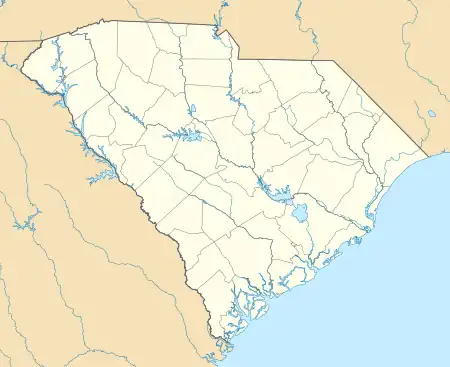Farmers' and Exchange Bank | |
.jpg.webp) Farmers' and Exchange Bank | |
  | |
| Location | 141 E. Bay St., Charleston, South Carolina |
|---|---|
| Coordinates | 32°46′39.5″N 79°55′38″W / 32.777639°N 79.92722°W |
| Built | 1853–54 |
| Architect | Edward C. Jones; Francis D. Lee |
| Architectural style | Moorish Revival, Exotic Revival |
| Part of | Charleston Historic District (ID66000964) |
| NRHP reference No. | 73001685 |
| Significant dates | |
| Added to NRHP | November 7, 1973[1] |
| Designated NHL | November 7, 1973[2] |
| Designated NHLDCP | October 9, 1960 |
The Farmers' and Exchange Bank is a historic commercial building in Charleston, South Carolina. Built in 1853–54, it is an architecturally distinctive building, with Moorish Revival features rarely seen in the United States. The building is recognizable for its use of muqarnas—characteristic of Persian and North African architecture—as well as its large arched windows and striking red sandstone facade. It was declared a National Historic Landmark in 1973.[2][3][4]
Description and history
The Farmers' and Exchange Bank is located on the west side of East Bay Street in the Charleston Historic District. It is a two-story masonry structure, built out of brick and multiple shades of brownstone, with stucco finish. Its main facade is three bays wide, each bay taken up by a tall arched opening with Moorish features. The first floor openings have a contoured shape, with circular windows above entries with intricately carved doors. The second-floor openings are similar, with the upper circular portion having a scalloped edge, and the arches filled with large multi-pane fixed windows.[4]
The building was designed by Edward C. Jones and Francis D. Lee, both Charleston architects, and was completed in 1854. Its design is probably based on depictions of Moorish architecture published in Washington Irving's The Alhambra, which was published around that time. It was for some time thought to have been influenced by the Regency architecture of Great Britain, specifically the "Hindu" influence of buildings of that period such as the Royal Pavilion in Brighton, but the architects have been judged unlikely to have been exposed to such influences.[4]
The structure was considered for demolition in the early 1970s but Charleston banker Hugh Lane Sr. contributed $50,000 toward its restoration.[5]
See also
References
- ↑ "National Register Information System". National Register of Historic Places. National Park Service. January 23, 2007.
- 1 2 "Farmers' and Exchange Bank". National Historic Landmark summary listing. National Park Service. Archived from the original on June 6, 2011. Retrieved March 7, 2008.
- ↑ "Farmers' and Exchange Bank, Charleston County (141 E. Bay St., Charleston)". National Register Properties in South Carolina listing. South Carolina Department of Archives and History. Retrieved March 7, 2008.
- 1 2 3 Tray Stephenson and Bernard Kearse (April 19, 1973). National Register of Historic Places Inventory-Nomination: Farmers' and Exchange Bank (pdf). National Park Service. and Accompanying one photo, exterior, undated (32 KB)
- ↑ "SC Structure Drew Inspiration from Washington Irving", Cotton Boll Conspiracy, July 14, 2017
External links
- Farmers' and Exchange Bank, Charleston County (141 E. Bay St., Charleston), at South Carolina Department of Archives and History
- Historic Charleston's Religious and Community Buildings, a National Park Service Discover Our Shared Heritage Travel Itinerary

